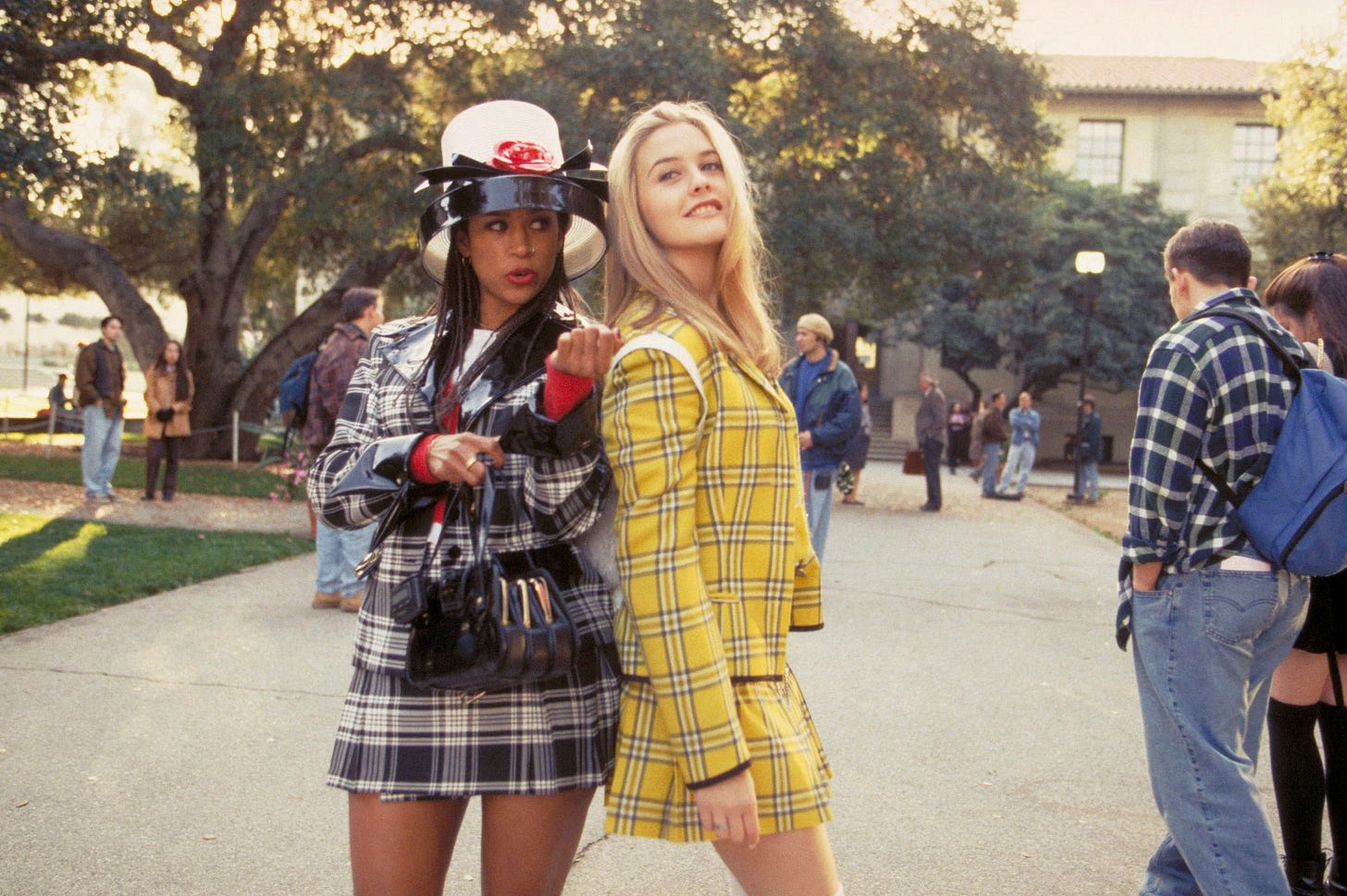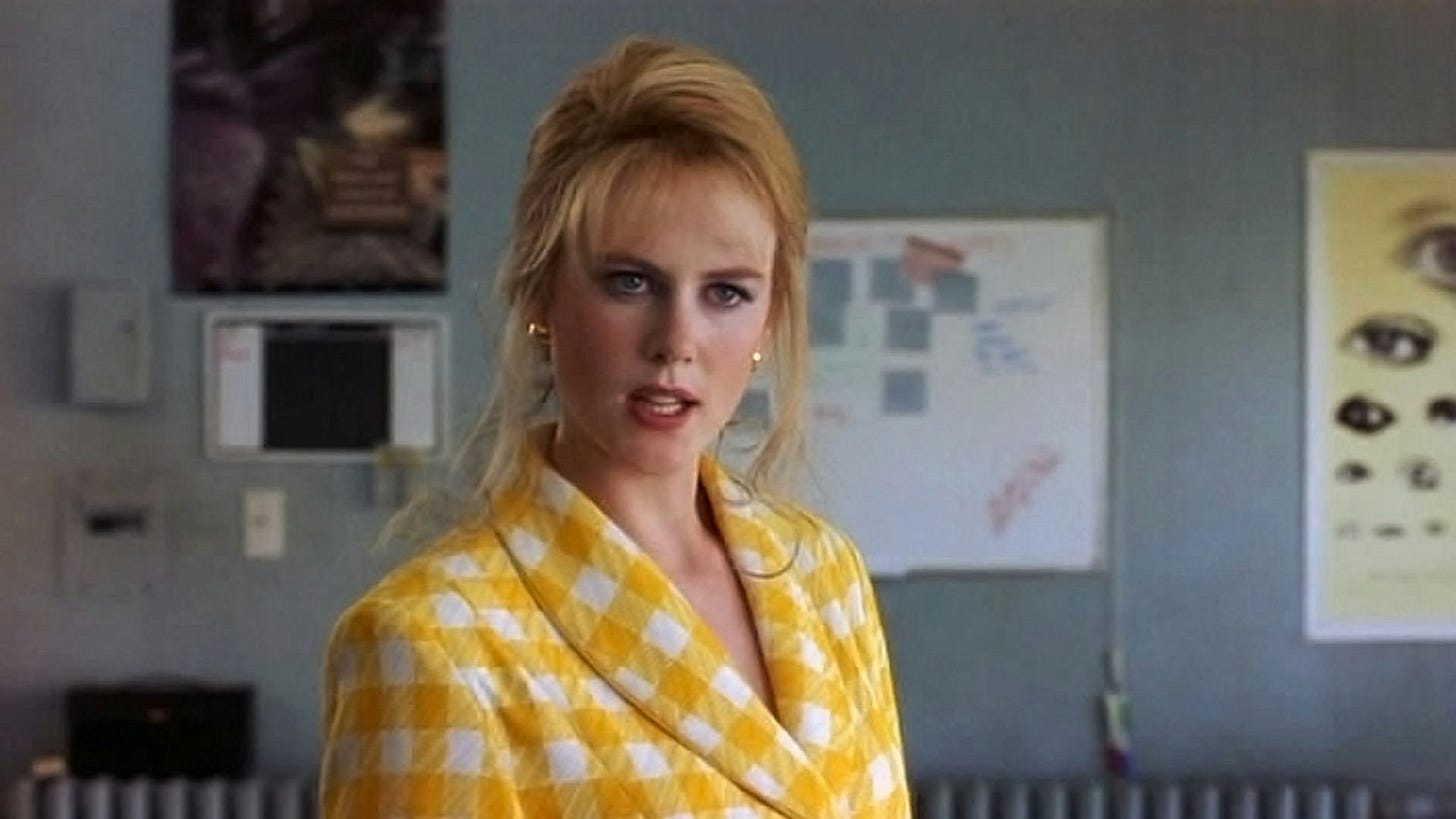One of my favorite conversations in cinema history takes place at the denouement of the 1995 cult comedy Party Girl. Mary, played by Parker Posey, has realized that to pursue her new love for library science she must take a step back from her beloved downtown New York party scene. Fittingly, she’s pulled back her hair, sold her rails of kitsch designer clothes, and chosen to wear a serious (but still designer) dark grey suit. Because, in an unprofessional lapse of judgment, she slept with her felafel-truck-owning love interest at work, she’s been fired from the New York Public Library. In an effort to beg for her job back, she invites her ex-boss/Godmother Judy to her apartment. However, when Mary flings open the front door, she’s greeted by a surprise birthday party. Amidst the chaos of trying to hide the festivities before Judy arrives, her friend yells “Mary! Those clothes were priceless, they were irreplaceable, what were you thinking?” to which she replies “I had to pay my rent!” It’s a small moment, but one that acknowledges the horror of accepting financial responsibility for oneself.
In the same year that Party Girl made history as the first film to premiere on the internet, Clueless smashed box-offices. When I first saw Clueless at 13, I didn’t think a better film could exist. Then I saw 10 Things I Hate About You. I fast discovered that the 1990s were, I think, a treasure trove of films about young women negotiating their intelligence and ambition with their ‘ditzy’ feminine charms. These comedies preached empathy, fashion, and parties - and I was smitten. Nothing ever really went wrong; they were like sweet milk chocolate truffles with slightly tangy, but ultimately sweet, strawberry centers. Clueless is a modern adaptation of Jane Austen’s Emma starring Alicia Silverstone as Cher - the kind, if sometimes misguided, daughter of a rich Beverly Hills lawyer. Cher is air-headed and self-absorbed, but she eventually redeems herself by looking past social hierarchy. Party Girl is Clueless’ meaner older sister. From the opening shot of a drag queen searching for her earring on the grimy stairs of a Soho apartment building, we know we aren’t in Beverly Hills anymore. We are in Mary’s world where popularity is crucial and you work hard to get it.
Mary is a remarkable character. She’s dressed in bright, mismatched ensembles that ooze expensive taste whilst recalling the mad choices of a child let loose in a Salvation Army. On a handsome woman speaking with monotone drollery, they’re the clothing choices of the coolest person in the room. There’s something inherently funny about seeing Posey, a certified 90s it-girl, decide to be a librarian. It’s a cinematic fact that being a librarian is a terrible fate for a woman. This is best established by the 1946 Christmas classic It’s A Wonderful Life. In the world reimagined without George Bailey most characters are dead, poor, or alcoholics except for his wife Mary. She’s reimagined as an unmarried, glasses-wearing librarian (it’s almost too much to bear!). So, the premise that a New York socialite steps foot in a library is comedic. Party Girl doesn’t strike comedy gold, however, until Mary falls in love with the job and applies her aggressively dry demeanor to upholding the sanctity of the Dewey Decimal System. There’s a lot to love about the supporting cast which includes revered drag performer Lady Bunny and the broadway star (and director’s mother) Sasha Von Scherler, but Party Girl is Parker Posey’s film.
Director Daisy Von Scherler Mayer and Parker Posey were fixtures of the New York club scene when they made Party Girl. It was shot in 19 days with a total budget of $150,000 and has a scruffy, homemade quality. At the time, it was popular for female-centered comedies to use deadpan humor and rough filmmaking to toe the line between amusement and gritty social commentary. If Party Girl is Clueless’ older sister, it’s partially because of this aesthetic. It’s also partially because where Cher’s narcissism is harmless, Mary’s isn’t. Mary's inane problem of choosing between parties and work is underpinned by anxieties about losing her social life and identity. Instead of expressing her nervousness endearingly, Mary is ungrateful, recalcitrant, and behaves in a manner that wouldn’t be considered politically correct by today’s standards (recent reviews comment on cultural appropriation). That’s not to say that all comedies need a sobering emotional core, but that Party Girl’s difficult edge is what has allowed it to endure.
Mary wasn’t the only complicated female protagonist to grace comedies in 1995; she was joined by Nicole Kidman’s Suzanne Stone. With a $20 million budget, a sensational true story, and a Cannes premiere, director Gus Van Sant’s To Die For was a completely different production. Aspiring weather-woman Suzanne is a satire of female characters like Cher: an ambitious anti-protagonist dressed like a pastel 90s fever dream of the 1950s. Cher spends most of Clueless matchmaking her teachers in an effort to get her grades raised. In To Die For, Suzanne pursues her dream career by seducing an underprivileged 16 year-old and manipulating him into murdering her husband. Suzanne may wear a yellow suit that’s eerily similar to Cher’s iconic plaid number, but Kidman’s face is infinitely more calculating than Silverstone’s. This face makes the oppressively coordinated wardrobe, unmoving blowout, and perfect makeup more terrifying than charming. Suzanne’s outline is Cher-esque, but her innards are much more wicked.
In 1974, Molly Haskell wrote a defining piece about the woman’s film. She described the genre, and its protagonists, as antidotes for women in the 1930s & 40s who had found themselves stuck. Marriage - the ultimate happy ending - hadn’t led anywhere. By the 90s, marriage wasn’t as universally promoted: in 1994 Muriel of Muriel’s Wedding dejectedly lied her way into being a bride only to decide that it’s more fun to go clubbing and work at a video store. This is a period in which women were being told that they could be anything; however, incumbent upon this permission was the expectation that women excel in their chosen field - not be video store clerks. Contrary to life according to Carrie Bradshaw and Andie Anderson, women can’t all move to expensive cities and write for fashion magazines. Denying women the possibility of professional mediocrity is stifling. Mary and Suzanne offer a release from that suffocation. Instead of being effortlessly talented, they’re manicured women obsessed with commonplace careers sacrificing their relationships with parents, friends, and boyfriends to little avail. Mary and Suzanne drive themselves mad over ‘normal’ careers, and in doing so join Haskell’s protagonists as defenses against the silver screen's ‘extraordinary woman’.
Party Girl and To Die For contribute to an alternative subgenre of women’s comedies that undermined Cher Horowitz just as she began to dominate. They’re ridiculously 90s, but there’s something in them that motivated Criterion to give both films 4K restorations in 2023. Maybe it’s that Parker Posey and Nicole Kidman are seminal actresses with prevailing appeal. Perhaps it’s the deadpan comedy, or phenomenal outfits. Personally, it's because these films scratch an unbelievable itch to see someone superficially perfect throw an abhorrent tantrum in the face of everyday obligations that it seems everyone achieves effortlessly except for me.








Imnsho, this is a brilliant, thought-provoking piece, not only at the level of film but society as well, as exemplified by the inclusion of To Die For, which, many may not know, was based on a true story that got a lot of press at the time, but has largely been forgotten since. Its juxtaposition with Party Girl (which I have not seen, but will have to after reading this review) here is striking in that for many of us, To Die For was the movie that showed us that Kidman was a serious actor and would be a force to be reckoned with.
By contrast, I felt that like many actresses, Alicia Silverstone never got the chances I thought she should've had after Clueless to show what she could do (Parker Posey seems to fall somewhere in between). This seems like a story within the story of this terrific collection of films and the author's analysis of them.